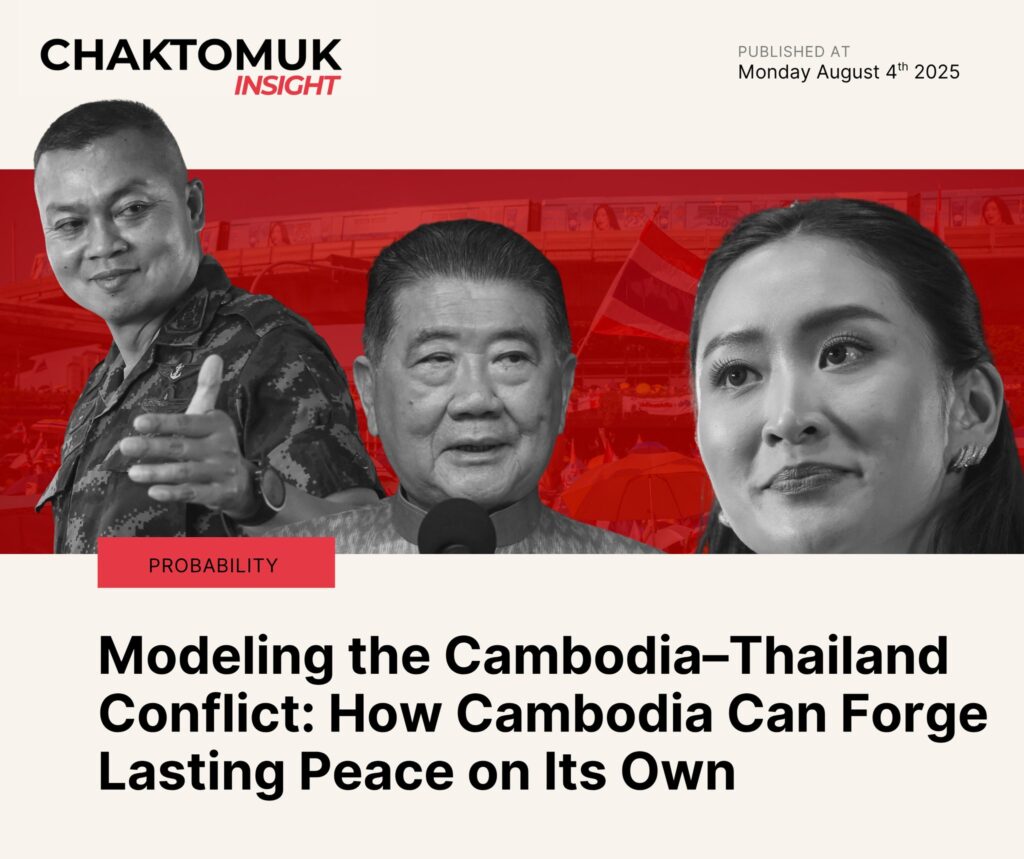y = α(Thai Domestic Politics) + β(Unclear Demarcated Border) + δ(Cambodia’s Economic & Military Power) + ε

I’d like to share my approach to understanding complex issues—using the Cambodia–Thailand conflict as an example. First, here are a few key principles I use when thinking analytically:
1. If you’re struggling to get your thinking straight, go to an extreme or very simplified the case.
2. The world is much more uncertain than you think—so think probabilistically.
3. Uncertainty is the friend of the status quo. If you don’t know what to do, then don’t act yet.
4. Good decisions can still lead to poor outcomes.
5. Information is valuable only if it can change your decision.
Now, back to the model:
• y: This represents the likelihood (probability) of conflict, ranging from 0-1.
• α, β, δ: These are weights (fancy math constants) representing how important each factor is. They can vary over time.
• ε: This is the “error term”—covering all other small, random factors that could affect the conflict but aren’t explicitly listed.
1. Thai Domestic Politics
This reflects the political and economic situation inside Thailand. For example, political instability or economic hardship can generate public dissatisfaction with the ruling establishment. In such cases, governments might look for a distraction—a fantasy common enemy like Cambodia—around which they can build a narrative to rally support and preserve legitimacy. Ironically, it is in our best interest to wish Thailand a stable government and a growing economy.
2. Unclear Demarcated Border
This is straightforward: as long as the border between Thailand and Cambodia remains poorly defined, the likelihood of conflict remains reasonably high.
3. Cambodia’s Economic & Military Power
This is more complex. At our current stage, Cambodia’s growing strength could be perceived by Bangkok as a threat—or at least as a sign that Thailand is losing leverage. In response, Thailand may feel compelled to reassert dominance through its military or economic superiority. In this case, Cambodia’s strength is positively correlated with the probability of conflict.
However, once Cambodia becomes strong enough—past a critical threshold—Thailand may begin to view conflict as a net negative. At that point, Cambodia’s strength will become negatively correlated with conflict likelihood. The key question is: when and how do we reach that critical juncture? Here are my two suggestions:
(1) Build Cambodia’s Total Defense Capability
As a small nation, Cambodia must understand that security isn’t just a military matter. The “Total Defense” concept includes diplomacy, civil, economic, social, psychological, digital, and military elements. Everyone plays a role—not just soldiers. This means:
• Presenting ourselves internationally as a peace-loving, trustworthy state.
• Building a resilient economy.
• Raising high-quality human capital.
Cambodia must develop the capacity to sting like a wasp—a credible deterrent despite our small size.
(2) Improve Trade Relations with Thailand
This may sound counterintuitive—perhaps even contradictory to the “buy local” movement—but these two goals are not mutually exclusive. In fact, I can prove they complement each other.
Trade generally benefits all involved parties. With over 800km of shared border, Cambodia and Thailand are natural trading partners—this fact cannot be changed. In Khmer, we call it កត្តាសត្យានុម័ត.
Trade between Cambodia and Thailand has been rising steadily. In the first half of 2025, bilateral trade reached 95.147 billion baht—up 3.33%—with Thailand enjoying nearly a 50-billion-baht trade surplus, according to Thailand’s Commerce Ministry.
Cambodia benefitted from having a wide range of products, especially those that she doesn’t have the competitive advantage. A win-win scenario for both countries.
Now, imagine a future in which Cambodia and Thailand have no trade relations. Thailand would have nothing to lose economically, making them less hesitant to take aggressive actions. This would be a lose–lose scenario. In short: no trade = less likelyhood of sustained peace.
But What About “Supporting Local Products”?
Some argue that supporting local products and trading with Thailand are conflicting goals. That’s a misconception.
No country—not even the world’s most powerful economies—has ever achieved full self-reliance. What’s practical is to support products made in Cambodia, and this includes those that depend on imported raw materials or intermediate goods (from Thailand or elsewhere). For instance:
• Cambodia may need Thai inputs to produce locally finished goods.
• Thailand might need Cambodian goods too.
• We could even co-develop regional supply chains.
Of course, Cambodia can source from other neighboring countries and even from China, which Cambodia should do anyway (diversification for a resilient economy), but if Thailand can offer a lower cost, businesses would want to have Thailand as an available option to increase our economy competitiveness.
Even if a product is under a Thai brand, but manufactured locally with local materials and labor, we should still support it. The key for Cambodia’s growth is to capture as much of the value chain as possible.
TL;DR:
A 2-pronged strategy for lasting peace in Cambodia–Thailand relations (from Cambodia’s perspective):
1. Build Cambodia’s Total Defense Capability
2. Increase interdependence through trade
Credit to:
Author: Kim Sopheakrakboth
Facebook Page: Chaktomuk Insight